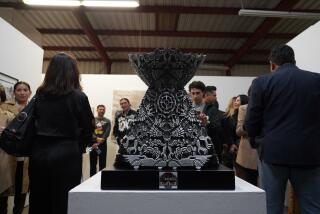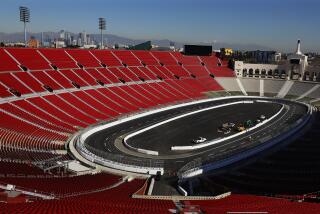Barlow Has Smooth Moves on Rocky Road in Baja 1000
- Share via
Sometime after midnight Friday, Steve Barlow hopes to celebrate an anniversary in winning style.
That’s when the Thousand Oaks resident figures he’ll be pulling into Ensenada in his modified Ford truck--the one equipped with 10 kidney-saving shock absorbers--at the conclusion of the 30th annual Baja 1000, considered the most grueling off-road race in the world.
Rain or shine, about 250 vehicles ranging from motorcycles to unlimited-production Trophy Trucks will hurtle across the Mexican desert in a day-long mad dash that tests the endurance and perseverance of every driver.
“It’s survival just to get through the course itself, let alone win the race,” Barlow said.
But that’s exactly what Barlow did 10 years ago. Following three days of rain that virtually washed out the course, Barlow drove his single-seat buggy to victory in his vehicle class in the 1987 Baja 1000, making him the season point champion.
“We went into that race third [in points],” Barlow recalled. “All we had to do was win and the leader had to finish fifth or worse. He finished sixth.”
Barlow is locked in a similar battle in this race, which starts at 8 a.m. He trails defending champion Chuck Harris of Las Vegas in the limited-production Protruck Class, but a victory in the final race of the season would give Barlow the points title.
“We’re looking for a repeat 10 years later,” Barlow said.
In 14 years of off-road racing, Barlow has driven vehicles in every imaginable condition--snow, rain, 120-degree temperatures.
Conquering the elements is usually a driver’s biggest obstacle, he said.
“You’re racing your competitors, but at Baja your meanest and worst competitor is the desert itself,” he said. “Baja always gives you all your money’s worth. You can never predict it because it can change at a moment’s notice.”
Sometimes the changes are the work of man rather than Mother Nature.
In the Baja 500 in June, Barlow encountered a couple of boulders on a mountain road that had been dislodged by locals. Barlow tried to drive over the boulders but they became wedged under the truck. When he attempted to back up, he rolled the right rear tire off the side of a cliff.
The truck remained in its precarious position for about 30 minutes before locals and Barlow’s support team dug and pulled the boulders away.
Barlow, who was contending for the lead at the time of the mishap, finished second in the Protruck Class.
“If we wouldn’t have gotten stuck, it would have been real close,” he said.
Barlow, who grew up in Fillmore, has been around off-road racing nearly his entire life. His father, Don, was a racing enthusiast who drove everything from “jalopies to dragsters,” until retiring in 1986.
Don Barlow, 67, is part of his son’s support crew.
Steve has been enamored with the Baja 1000 since he first traveled to the race with his family in 1974, when he was 10.
“I really enjoy Mexico,” he said. “It kind of levels the playing field for everyone.”
Like the Rose Bowl in college football, the Baja 1000 is considered the “granddaddy” of off-road races. Among those who have tested the course are Indy Car drivers Rick and Roger Mears and Parnelli Jones, and actors Steve McQueen and James Garner.
Ivan “Ironman” Stewart, the Michael Jordan of off-road racing, drives his Trophy Truck in Baja and is a perennial crowd favorite.
Barlow has not raced in the Baja 1000 since 1992 but his experience should serve him well. He said first-time competitors often struggle in a race that is determined as much by luck and preparation as driving skill.
Adapting to outrageous conditions is usually par for the course.
During his rain-soaked victory in 1987, Barlow’s helmet shield became so scratched from wiping away mud that he had to open it for the final part of the race. By the time he finished, his entire face was packed with mud.
“Adrenaline keeps you going, but afterward you don’t know how you made it,” he said.
The race Friday will cover 750 miles, following a course that starts in Ensenada and travels south near San Felipe before returning to Ensenada. Barlow estimated he will average about 50 mph and reach a top speed of 120 mph on a course that is about 15 miles of paved road and the rest desert terrain.
The Baja 1000 actually covers 1000 miles only once every three years, with the longer race scheduled for next year.
Barlow, part-owner in a restaurant chain, said it will cost him $15,000 to run the race. That covers the cost of equipment and 220 gallons of racing fuel needed to complete the course within an estimated 16 to 18 hours.
His racing team numbers 30 people, including six chase crews that leap-frog each other along the course to refuel Barlow’s truck and make needed repairs.
Co-driver Mike Dubrieuel of Moorpark serves as navigator. Back-up driver John Swift of Oxnard, a former Baja 1000 winner, will cover the first “couple hundred” miles before Barlow takes over.
Safety equipment, which includes a fireproof suit, air-cooled helmet and kidney belt, has helped Barlow avoid serious injury over the years. Barlow rolled his truck when the steering line broke during a race in Laughlin, Nev., in September but he was unhurt.
Although off-road racing involves running roughshod over uneven terrain, Barlow said his truck’s fiberglass body and 36-inch shock absorbers make for a deceptively smooth ride.
The shocks--two on each front wheel and three on each back wheel--cost $700 apiece and allow each wheel to travel, or bounce, up to 24 inches. Wheel travel on most standard vehicles is four to six inches.
“It’s kind of like riding on an airplane,” Barlow said. “You’d be amazed at how incredibly smooth [the ride] is. It still beats you up because you’re running at a high rate of speed, but the vehicles take [bumps] incredibly well.”
Barlow said the exhilaration at the finish of the Baja 1000 is unmatched in off-road racing. Hundreds of people crowd the road leading into Ensenada to cheer the drivers.
“It’s almost like dividing a wave when you part the crowd,” he said. “It’s kind of hairy. People are all over and they want to touch the car.”
But don’t think Barlow is complaining.
“It’s a lot of fun,” he said.
More to Read
Go beyond the scoreboard
Get the latest on L.A.'s teams in the daily Sports Report newsletter.
You may occasionally receive promotional content from the Los Angeles Times.










